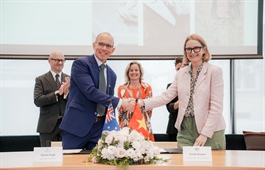Textile producers prepared for barrage of disruption
Textile producers prepared for barrage of disruption
Vietnamese enterprises are trading well so far this year, but key exporters in textiles, garments, leather, and footwear are still suffering from increasing raw material costs.

In the first six months of 2022, the total import and export turnover of goods reached $371.17 billion, up 16.4 per cent over the same period last year, of which exports increased by 17.3 per cent on-year; imports rose by 15.5 per cent on-year. The balance of trade in goods in the first six months of the year was estimated to have a trade surplus of $710 million according to the General Statistics Office of Vietnam.
Phan Thi Thanh Xuan, vice chairwoman of the Vietnam Leather, Footwear and Handbag Association said at a Ministry of Planning and Investment (MPI) conference last week that the industry has recovered strongly with more orders and double-digit growth in exports.
“However, enterprises in the industry are facing high inventory rates, high logistics costs, a shortage of labour, and disruption of the supply chain of raw materials and accessories. This is mainly due to China, the main source of raw materials for the industry, still pursuing its strict pandemic policy,” she said.
The same is happening in textiles and garments. Vietnam’s exports of these products reached an all-time high of $22 billion in the first six months of 2022, up 23 per cent on-year, but SSI Research said that the average price of imported yarn increased by 10 per cent year-on-year due to higher cotton and oil prices, along with high anchoring logistics costs.
According to domestic garment manufacturers, customers have shortened the time to take orders due to high inventory levels in the export market and inflationary pressures. Previously, customers usually ordered six months in advance, now they only order three months in advance.
Therefore, it is estimated that the revenue growth of textile and garment manufacturing companies in Vietnam will decelerate in the next six months. Besides that, rising oil prices and competition in the labour market is negatively impacting the entire textile supply chain, from manufacturer to retailer.
Listed Thanh Cong Textile Garment Investment Trading JSC reported that it faces rising raw material and transportation costs, leading to lower profit margins. Its Vinh Long factory just started operating in April, but currently only five production lines out of a total of 29 are in operation.
Than Duc Viet, general director of Garment 10 Corporation, said that it has had to change its market assessment of the third quarter and the fourth quarter.
“The factory may fall into a vicious circle of rising input prices. In general, it is possible that our business performance in the first half of the year has still been good, but the second half of the year will face difficulties,” he told VIR.
Associations reported to the MPI that the increase in input material prices has caused headaches for industries since 2020, but the situation has been exacerbated due to the Ukraine conflict. The Vietnam Association of Seafood Exporters and Producers has also shared that seafood exports faced some major challenges in the rest of the year, including increased freight rates along with input costs. Shrimp export prices are forecasted to continue to increase, even to skyrocket, especially by the end of the third quarter.
The government set a target of increasing export turnover by 6 to 8 per cent from 2021, which recorded $336.25 billion, while the trade balance will maintain a surplus.




















